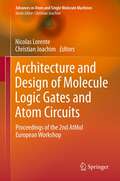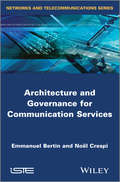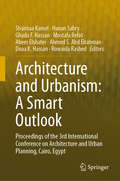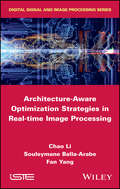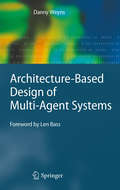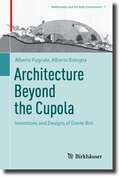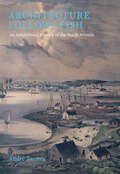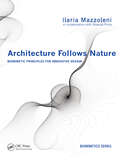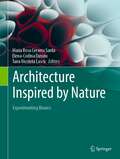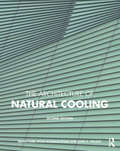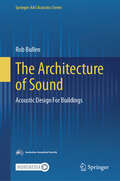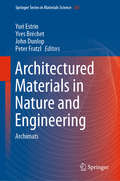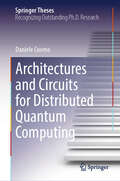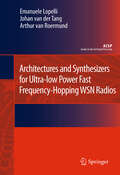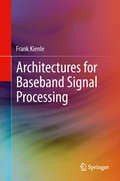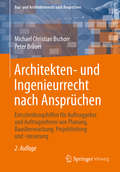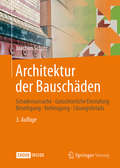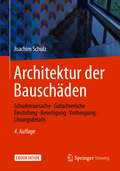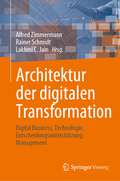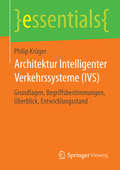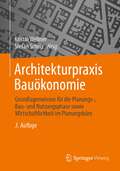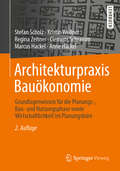- Table View
- List View
Architecture and Design of Molecule Logic Gates and Atom Circuits: Proceedings of the 2nd AtMol European Workshop (Advances in Atom and Single Molecule Machines)
by Christian Joachim Nicolas LorenteHave you ever puzzled over how to perform Boolean logic at the atomic scale? Or wondered how you can carry out more general calculations in one single molecule or using a surface dangling bond atomic scale circuit? This volume gives you an update on the design of single molecule devices, such as recitfiers, switches and transistors, more advanced semi-classical and quantum boolean gates integrated in a single molecule or constructed atom by atom on a passivated semi-conductor surface and describes their interconnections with adapted nano-scale wiring. The main contributors to the field of single molecule logic gates and surface dangling bond atomic scale circuits theory and design, were brought together for the first time to contribute on topics such as molecule circuits, surface dangling bond circuits, quantum controlled logic gates and molecular qubits. Contributions in this volume originate from the Barcelona workshop of the AtMol conference series, held from January 12-13 2012.
Architecture and Governance for Communication Services
by Noël Crespi Emmanuel BertinCommunication services are evolving at an unprecedented rate. No longer limited to interpersonal vocal communication, they now integrate functions such as address books, content sharing and messaging. The emergence of social networks – which may also include these features – is an important element of this transformation. Content services are becoming flagship services themselves, and are sometimes paired up with conversation services. The boundaries between different services are becoming less and less distinct. This book meets the need for a better understanding of communication services, and for a general framework of their description. A detailed overview on service architecture in the Telco, Web and IT worlds is presented, offering a roadmap with explanations on how to improve the architecture and governance of communication service architectures by exploiting the syntax and semantics that are common to different services is clearly outlined. This book also responds to recurring questions about service design, such as the functional scope of enablers or SOA (Service Oriented Architecture) services, the relevance of service composition to the user and collaboration between different services in a converged environment. Many concrete examples from telecoms service providers’ operations illustrate these concepts. Contents 1. Describing Service Architectures. 2. Convergence of Service. 3. Building an Architectural Framework for Telecom Services. 4. Modeling and Case Study. 5. Organizational and Software Applications. About the Authors Emmanuel Bertin is senior service architect at Orange Labs in France. He is the author of more than 40 research papers, and holds more than 10 patents in the area of communication services. Noël Crespi worked at Bouygues Telecom, France Telecom R&D, and then at Nortel Networks where he led the Telephony Programme. He is currently Professor and Head of the Service Architecture Laboratory at Institut Mines-Telecom, Telecom SudParis in France and is the author/co-author of more than 160 research papers and 140 contributions in standardization.
Architecture and Principles of Systems Engineering (Complex and Enterprise Systems Engineering)
by Charles Dickerson Dimitri N. MavrisThe rapid evolution of technical capabilities in the systems engineering (SE) community requires constant clarification of how to answer the following questions: What is Systems Architecture? How does it relate to Systems Engineering? What is the role of a Systems Architect? How should Systems Architecture be practiced?A perpetual reassessment of concepts and practices is taking place across various systems disciplines at every level in the SE community. Architecture and Principles of Systems Engineering addresses these integral issues and prepares you for changes that will be occurring for years to come. With their simplified discussion of SE, the authors avoid an overly broad analysis of concepts and terminology. Applying their substantial experience in the academic, government, and commercial R&D sectors, this book is organized into detailed sections on: Foundations of Architecture and Systems Engineering Modeling Languages, Frameworks, and Graphical Tools Using Architecture Models in Systems Analysis and Design Aerospace and Defense Systems Engineering Describing ways to improve methods of reasoning and thinking about architecture and systems, the text integrates concepts, standards, and terminologies that embody emerging model-based approaches but remain rooted in the long-standing practices of engineering, science, and mathematics. With an emphasis on maintaining conceptual integrity in system design, this text describes succinct practical approaches that can be applied to the vast array of issues that readers must resolve on a regular basis. An exploration of the important questions above, this book presents the authors’ invaluable experience and insights regarding the path to the future, based on what they have seen work through the power of model-based approaches to architecture and systems engineering.
Architecture and Urbanism: Proceedings of the 3rd International Conference on Architecture and Urban Planning, Cairo, Egypt
by Shaimaa Kamel Hanan Sabry Ghada F. Hassan Mostafa Refat Abeer Elshater Ahmed S. Abd Elrahman Doaa K. Hassan Rowaida RashedThis proceedings addresses the challenges of urbanization that gravely affect the world’s ecosystems. To become efficiently sustainable and regenerative, buildings and cities need to adopt smart solutions. This book discusses innovations of the built environment while depicting how such practices can transform future buildings and urban areas into places of higher value and quality. The book aims to examine the interrelationship between people, nature and technology, which is essential in pursuing smart environments that optimize human wellbeing, motivation and vitality, as well as promoting cohesive and inclusive societies: Urban Sociology - Community Involvement - Place-making and Cultural Continuity – Environmental Psychology - Smart living - Just City. The book presents exemplary practical experiences that reflect smart strategies, technologies and innovations, by established and emerging professionals, provides a forum of real-life discourse. The primary audience for the work will be from the fields of architecture, urban planning and built-environment systems, including multi-disciplinary academics as well as professionals.
Architecture-Aware Optimization Strategies in Real-time Image Processing
by Chao Li Souleymane Balla-Arabe Fan YangIn the field of image processing, many applications require real-time execution, particularly those in the domains of medicine, robotics and transmission, to name but a few. Recent technological developments have allowed for the integration of more complex algorithms with large data volume into embedded systems, in turn producing a series of new sophisticated electronic architectures at affordable prices. This book performs an in-depth survey on this topic. It is primarily written for those who are familiar with the basics of image processing and want to implement the target processing design using different electronic platforms for computing acceleration. The authors present techniques and approaches, step by step, through illustrative examples. This book is also suitable for electronics/embedded systems engineers who want to consider image processing applications as sufficient imaging algorithm details are given to facilitate their understanding.
Architecture-Based Design of Multi-Agent Systems
by Danny WeynsMulti-agent systems are claimed to be especially suited to the development of software systems that are decentralized, can deal flexibly with dynamic conditions, and are open to system components that come and go. This is why they are used in domains such as manufacturing control, automated vehicles, and e-commerce markets. Danny Weyns' book is organized according to the postulate that "developing multi-agent systems is 95% software engineering and 5% multi-agent systems theory." He presents a software engineering approach for multi-agent systems that is heavily based on software architecture - with, for example, tailored patterns such as "situated agent", "virtual environment", and "selective perception" - and on middleware for distributed coordination - with programming abstractions such as "views" and "roles." Next he shows the feasibility and applicability of this approach with the development of an automated transportation system consisting of a number of automatic guided vehicles transporting loads in an industrial setting. Weyns puts the development of multi-agent systems into a larger perspective with traditional software engineering approaches. With this, he opens up opportunities to exploit the body of knowledge developed in the multi-agent systems community to tackle some of the difficult challenges of modern-day software systems, such as decentralized control, location-awareness, self-adaption, and large-scale. Thus his book is of interest for both researchers and industrial software engineers who develop applications in areas such as distributed control systems and mobile applications where such requirements are of crucial importance.
Architecture Beyond the Cupola: Inventions and Designs of Dante Bini (Mathematics and the Built Environment #7)
by Alberto Pugnale Alberto BolognaThis book reviews Dante Bini’s inventions and designs, focusing on his form-resistant Binishell and other pneumatic construction systems. Dante Bini’s double profile of architect and builder underpins the narrative of the entire book. It is used to analyse the evolution of the early reinforced-concrete Binishell patent into a variety of automated construction systems based on the use of air. Dante Bini has always been quite proactive in promoting his work and disseminating the results of his experimentations and achievements via journal articles, conference presentations and public talks; promotional brochures in multiple languages were also prepared to export and license his patents in various countries, from Italy to the Americas and Australia. Despite this, a rigorous study of Dante Bini’s work is still unavailable, and the relevance of this figure to contemporary architecture has yet to be discussed comprehensively. This book fills in this gap and arrives at the right time: during the last two decades, there has been an exponential interest in shell and spatial structures, particularly concerning the use of complex geometries and innovative construction techniques. This book will be of interest to academics in architectural design, theory and construction history, and practitioners and students interested in expanding their knowledge in the design and construction of shell and spatial structures.
Architecture Follows Fish: An Amphibious History of the North Atlantic
by Andre TavaresA highly original exploration of the history of architecture in relation to fish, shedding light on the connection between marine environments and terrestrial landscapes.Architecture Follows Fish is set in the North Atlantic, and its protagonist is fish. In this book author and architect André Tavares explores the notion of fishing architecture, a concept coined to describe architectural practices that are spawned by fisheries. To encompass the scope of fishing architecture, and to establish the connections between marine ecology and architectural practice, the book oscillates between different continents, centuries, and species. Fisheries are unique, and this book sheds light on that uniqueness through an articulated narrative and a wealth of iconography.Up until now there has been no history of architecture from the perspective of fish, although there are counterparts for meat, timber, oil, and many other industries. Tavares provides a counternarrative to the traditional history of marine environments, which tends to focus on water ecosystems, and instead forms a bridge between what happens at sea and what happens on land. The hope is that, after reading this book, readers will better understand life in the sea in relation to urban growth and terrestrial landscapes.
Architecture Follows Nature-Biomimetic Principles for Innovative Design (Biomimetics Series)
by Ilaria MazzoleniThis full-color volume proposes an innovative methodology that uses the functional aspects of nature to inspire improvements in building design and form, encouraging designers to apply biomimetic principles to architectural processes. The book focuses on the analysis of various animal skins, translating the principles of communication, thermoregulation, water balance, and protection into the built environment. Illustrating how biomimetic principles can create a more sustainable way of building, this is the first time the author's new methodology-as well as the 12 case studies-has been published.
Architecture Inspired by Nature: Experimenting Bionics
by María Rosa Cervera Sardá Elena-Codina Dușoiu Tana Nicoleta LascuThe book brings together the research completed during 10 editions of International Seminars of Bionics, organized by the School of Architecture of the University of Alcalá de Henares, Madrid, several of them in partnership with the “Ion Mincu” University of Architecture and Urbanism, Bucharest, carried out in Spain and in Romania. The articles here consider advanced bionic design principles, implementing them to an impressive variety of application fields, including, but not limited to, urban planning and landscape, public space, architecture and building structures, design and detailing, application of natural dynamic processes, bio-digital architecture, innovative materials based on living organisms (micro-algae), and nano-modified materials. A particular focus is given to light and perception of light. To illustrate the principles developed, this contributed volume includes descriptions and full-color images of the experimental projects created during the workshops held in the framework of these ISB meetings: Learning from Nature, Integrating Bionics (2009); Adaptability, Efficiency and Biostructures (2010); Bionics and Innovation (2011); Forms and Structures Inspired by Nature (2016, 2017); Furniture Inspired by Natural Models (2018); Relation between Structure and Envelope: Light Structures (2019); Light, from Nature to Architecture. Structures Inspired in Nature (2020); Light in Architecture and Design: A Bionic Perspective (2021); Sustainable Thinking and Bionics (2022).
Architecture of Brazil: 1900-1990
by Hugo SegawaArchitecture of Brazil: 1900-1990 examines the processes that underpin modern Brazilian architecture under various influences and characterizes different understandings of modernity, evident in the chapter topics of this book. Accordingly, the author does not give overall preference to particular architects nor works, with the exception of a few specific works and architects, including Warchavchik, Niemeyer, Lucio Costa, and Vilanova Artigas.
The Architecture of Natural Cooling
by Brian Ford Rosa Schiano-Phan Juan A. VallejoOverheating in buildings is commonplace. This book describes how we can keep cool without conventional air-conditioning: improving comfort and productivity while reducing energy costs and carbon emissions. It provides architects, engineers and policy makers with a ‘how-to’ guide to the application of natural cooling in new and existing buildings. It demonstrates, through reference to numerous examples, that natural cooling is viable in most climates around the world. This completely revised and expanded second edition includes: An overview of natural cooling past and present. Guidance on the principles and strategies that can be adopted. A review of the applicability of different strategies. Explanation of simplified tools for performance assessment. A review of components and controls. A detailed evaluation of case studies from the USA, Europe, India and China. This book is not just for the technical specialist, as it also provides a general grounding in how to avoid or minimise air-conditioning. Importantly, it demonstrates that understanding our environment, rather than fighting it, will help us to live sustainably in our rapidly warming world.
The Architecture of Sound: Acoustic Design For Buildings (Springer-AAS Acoustics Series)
by Rob BullenThis book highlights the range of issues involved in designing interior spaces for acoustics—that is, ensuring that the sound of a space matches its function. The book presents the principles of acoustic design, together with practical advice on how to apply those principles. The fundamental elements of background sound, intruding sound, sound quality, and speech intelligibility are each described, with design goals, calculation procedures, and advice on implementation. Contemporary challenges associated with integrating acoustics and sustainable building design are also covered. Finally, two types of space—school classrooms and hospital wards—are considered in detail, as examples.
Architectured Materials in Nature and Engineering: Archimats (Springer Series in Materials Science #282)
by Yuri Estrin Yves Bréchet John Dunlop Peter FratzlThis book deals with a group of architectured materials. These are hybrid materials in which the constituents (even strongly dissimilar ones) are combined in a given topology and geometry to provide otherwise conflicting properties. The hybridization presented in the book occurs at various levels - from the molecular to the macroscopic (say, sub-centimeter) ones. This monograph represents a collection of programmatic chapters, defining archimats and summarizing the results obtained by using the geometry-inspired materials design. The area of architectured or geometry-inspired materials has reached a certain level of maturity and visibility for a comprehensive presentation in book form. It is written by a group of authors who are active researchers working on various aspects of architectured materials. Through its 14 chapters, the book provides definitions and descriptions of the archetypes of architectured materials and addresses the various techniques in which they can be designed, optimized, and manufactured. It covers a broad realm of archimats, from the ones occurring in nature to those that have been engineered, and discusses a range of their possible applications. The book provides inspiring and scientifically profound, yet entertaining, reading for the materials science community and beyond.
Architectures and Circuits for Distributed Quantum Computing (Springer Theses)
by Daniele CuomoThis thesis treats networks providing quantum computation based on distributed paradigms. Compared to architectures relying on one processor, a network promises to be more scalable and less fault-prone. Developing a distributed system able to provide practical quantum computation comes with numerous challenges, each of which need to be faced with careful analysis in order to create a seamless integration of multiple engineered components.In accordance with hardware technologies, currently under development worldwide, telegates represent the fundamental inter-processor operations. Each telegate consists of several tasks: i) entanglement generation and distribution, ii) local operations, and iii) classical communications. Entanglement generation and distribution is an expensive resource, as it is time-consuming. The primary contribution of this thesis lies in the extensive analysis of some complex scenarios of general interest. We propose numerical models that help to identifythe interdependence between computation and communication. With the support of some of the best tools for reasoning -- i.e. network optimization, circuit manipulation, group theory and ZX-calculus -- we lay out new perspectives on the way a distributed quantum computing system should be developed.
Architectures and Synthesizers for Ultra-low Power Fast Frequency-Hopping WSN Radios (Analog Circuits and Signal Processing)
by Arthur H.M. van Roermund Emanuele Lopelli Johan van der TangWireless sensor networks have the potential to become the third wireless revolution after wireless voice networks in the 80s and wireless data networks in the late 90s. Unfortunately, radio power consumption is still a major bottleneck to the wide adoption of this technology. Different directions have been explored to minimize the radio consumption, but the major drawback of the proposed solutions is a reduced wireless link robustness. The primary goal of Architectures and Synthesizers for Ultra-low Power Fast Frequency-Hopping WSN Radios is to discuss, in detail, existing and new architectural and circuit level solutions for ultra-low power, robust, uni-directional and bi-directional radio links. Architectures and Synthesizers for Ultra-low Power Fast Frequency-Hopping WSN Radios guides the reader through the many system, circuit and technology trade-offs he will be facing in the design of communication systems for wireless sensor networks. Finally, this book, through different examples realized in both advanced CMOS and bipolar technologies opens a new path in the radio design, showing how radio link robustness can be guaranteed by techniques that were previously exclusively used in radio systems for middle or high end applications like Bluetooth and military communications while still minimizing the overall system power consumption.
Architectures for Baseband Signal Processing
by Frank KienleThis book addresses challenges faced by both the algorithm designer and the chip designer, who need to deal with the ongoing increase of algorithmic complexity and required data throughput for today's mobile applications. The focus is on implementation aspects and implementation constraints of individual components that are needed in transceivers for current standards, such as UMTS, LTE, WiMAX and DVB-S2. The application domain is the so called outer receiver, which comprises the channel coding, interleaving stages, modulator, and multiple antenna transmission. Throughout the book, the focus is on advanced algorithms that are actually in use in modern communications systems. Their basic principles are always derived with a focus on the resulting communications and implementation performance. As a result, this book serves as a valuable reference for two, typically disparate audiences in communication systems and hardware design.
Architekten- und Ingenieurrecht nach Ansprüchen: Entscheidungshilfen für Auftraggeber und Auftragnehmer von Planung, Bauüberwachung, Projektleitung und -steuerung (Bau- und Architektenrecht nach Ansprüchen)
by Michael Christian Bschorr Peter BräuerNach Anspruchsgrundlagen geordnet werden die tatbestandlichen Voraussetzungen aller relevanten Ansprüche von Auftraggebern und Auftragnehmern von Planungs-, Objektüberwachungs-, Projektleistungs- und Projektsteuerungsleistungen dargestellt. Ablaufdiagramme und graphische Erläuterungen bieten dem Leser einen schnellen Überblick und praxisnahe Hilfestellungen. Die vorliegende 2. Auflage berücksichtigt das zum 1. Januar 2018 reformierte Werkvertragsrecht des BGB.
Architektur der Bauschäden: Schadensursache - Gutachterliche Einstufung - Beseitigung - Vorbeugung - Lösungsdetails
by Joachim SchulzAnhand von ca. 110 Beispielen, untergliedert nach Bauteilen, werden Planungs- und Ausführungsfehler vorgestellt und wie folgt analysiert: - Schadensursache - gutachterliche Einstufung - Beseitigung - Vorbeugung Nach dem Motto "Bauen ist ein Kampf mit dem Wasser" wird als Schwerpunktthema der Bereich Feuchteschäden an Balkonen, Terrassen, WU-Beton-Kellern, Lichtschächten, Kelleraußentreppen, Rampen usw. behandelt. Da durch mangelhafte Ausführung aus guten Baustoffen oft schlechte Bauteile entstehen, soll der Planer vorbeugend auf mögliche Ausführungsfehler aufmerksam gemacht werden. Die 2. Auflage wurde überarbeitet und um neue aktuelle Beispiele ergänzt.
Architektur der Bauschäden: Schadensursache - Gutachterliche Einstufung - Beseitigung - Vorbeugung - Lösungsdetails
by Joachim SchulzAnhand von ca. 170 Beispielen, mit über 120 Prinzipskizzen, untergliedert nach Bauteilen, werden Planungs- und Ausführungsfehler vorgestellt und wie folgt analysiert: Schadensursache - gutachterliche Einstufung - Beseitigung - Vorbeugung. Nach dem Motto "Bauen ist ein Kampf mit dem Wasser" wird als Schwerpunktthema der Bereich Feuchteschäden an Balkonen, Terrassen, WU-Beton-Kellern, Lichtschächten, Kelleraußentreppen, Rampen usw. behandelt. Da durch mangelhafte Ausführung aus guten Baustoffen oft schlechte Bauteile entstehen, soll der Planer vorbeugend auf mögliche Ausführungsfehler aufmerksam gemacht werden. Die 4. Auflage wurde überarbeitet, aktualisiert und um neue Beispiele und Themenkomplexe ergänzt.
Architektur der Bauschäden: Schadensursache - Gutachterliche Einstufung - Beseitigung - Vorbeugung - Lösungsdetails
by Joachim SchulzAnhand von ca. 110 Beispielen, untergliedert nach Bauteilen, werden Planungs- und Ausführungsfehler vorgestellt und wie folgt analysiert: - Schadensursache - gutachterliche Einstufung - Beseitigung - Vorbeugung Nach dem Motto "Bauen ist ein Kampf mit dem Wasser" wird als Schwerpunktthema der Bereich Feuchteschäden an Balkonen, Terrassen, WU-Beton-Kellern, Lichtschächten, Kelleraußentreppen, Rampen usw. behandelt. Da durch mangelhafte Ausführung aus guten Baustoffen oft schlechte Bauteile entstehen, soll der Planer vorbeugend auf mögliche Ausführungsfehler aufmerksam gemacht werden. Die 2. Auflage wurde überarbeitet und um neue aktuelle Beispiele ergänzt.
Architektur der digitalen Transformation: Digital Business, Technologie, Entscheidungsunterstützung, Management
by Alfred Zimmermann Rainer Schmidt Lakhmi C. JainDieses forschungsorientierte Buch enthält wichtige Beiträge zur Gestaltung der digitalen Transformation. Es umfasst die folgenden Hauptabschnitte in 20 Kapiteln:- Digitale Transformation- Digitales Geschäft- Digitale Architektur- Entscheidungshilfe- Digitale Anwendungen Es konzentriert sich auf digitale Architekturen für intelligente digitale Produkte und Dienstleistungen und ist eine wertvolle Ressource für Forscher, Doktoranden, Postgraduierte, Absolventen, Studenten, Akademiker und Praktiker, die sich für die digitale Transformation interessieren.
Architektur Intelligenter Verkehrssysteme: Grundlagen, Begriffsbestimmungen, Überblick, Entwicklungsstand (essentials)
by Philip KrügerPhilip Krüger liefert einen Überblick zur Architektur Intelligenter Verkehrssysteme (IVS) und vermittelt wichtige Grundlagen und Entwicklungstrends im Themenfeld. Der Autor beschreibt den Fortschritt in Deutschland zur Erarbeitung einer umfassenden und intermodalen IVS-Architektur und bewertet diesen genauer. Für die koordinierte und harmonisierte Weiterentwicklung von IVS werden Rahmenbedingungen benötigt, wie sie in einer nationalen IVS-Architektur beschrieben sind. Dabei darf eine nationale IVS-Architektur nicht als Hemmnis für Innovationen verstanden werden, sondern vielmehr als Basis jeder systematischen Weiter- und Neuentwicklung von IVS.
Architekturpraxis Bauökonomie: Grundlagenwissen für die Planungs-, Bau- und Nutzungsphase sowie Wirtschaftlichkeit im Planungsbüro
by Kristin Wellner Stefan ScholzDieses Lehrbuch stellt das komplexe Tätigkeitsfeld der Architekt*innen aus planerischer-, bauökonomischer und immobilienwirtschaftlicher Sicht dar. Die Aufgaben des*der Architekt*in werden prozessorientiert im Sinne des Planungs- und Bauprozesses dargestellt. Ein weiteres Thema ist die Wirtschaftlichkeit im Architekturbüro selbst. Das Lehrbuch gibt so – aufbauend auf den Einführungstexten in die Bauökonomie und Immobilienwirtschaft – einen Überblick über alle für die Architekt*innentätigkeit relevanten ökonomischen Inhalte und vertieft die besonders praxisrelevanten Themen ausführlich. Neu in der 3. Auflage: Das Thema Haftung wurde komplett überarbeitet und alle Rechtsthemen aktualisiert. Außerdem wurde Wert auf die übergreifende Einbindung der Bedeutung von Lebenszykluskostenanalyse und Digitalisierung gelegt.
Architekturpraxis Bauökonomie: Grundlagenwissen für die Planungs-, Bau- und Nutzungsphase sowie Wirtschaftlichkeit im Planungsbüro
by Regina Zeitner Stefan Scholz Kristin Wellner Clemens Schramm Marcus Hackel Anne HackelDieses Lehrbuch stellt das komplexe Tätigkeitsfeld des Architekten aus planungs- und bauökonomischer Sicht dar. Die Aufgaben des Architekten werden prozessorientiert im Sinne eines Qualitätsmanagementsystems vermittelt beginnend bei den Kernprozessen der Planung bis zur Realisierung des Bauvorhabens.
